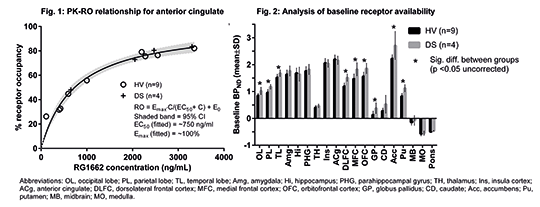Print version
Search Pub Med
PET imaging of GABAA α5 receptor availability and occupancy by RG1662, in individuals with Down syndrome and healthy controls. Memory impairment following benzodiazepine use is thought to be due mainly to agonism of GABAA α5 receptors (GABAA α5 R), whilst down regulation of GABAA α5 R is associated with improved cognition in animal models. In addition excessive GABAergic inhibition is thought to play a role in learning and memory deficits observed in Down syndrome (DS). Therefore it is hypothesised that negative allosteric modulators (NAMs) of GABAA α5 R may improve learning and memory in people with DS. RG1662 is a potent GABAA α5 R selective NAM being developed for the treatment of intellectual disability associated with DS. We conducted a positron emission tomography (PET) study (ClinicalTrials.gov identifier NCT01667367) to evaluate the relationship between RG1662 plasma concentration and receptor occupancy (RO), and compare GABAA α5 R availability in subjects with DS and healthy volunteers (HV). Nine HV (7 M:2 F; 21-39 y) and four subjects with DS (4 M; 19-29 y) each had two dynamic PET scans following i.v. admin. of the GABAA α5 preferring radioligand [11C]RO15-4513. Subjects received single doses of 20 mg-1000 mg of RG1662 or placebo p.o, 3–5 h prior to the start of each PET scan. Plasma samples were collected for measurement of RG1662. Regions of interest (ROI) were defined on an MRI obtained for each subject. PET data was quantified with the simplified reference tissue model, using the cerebellum as a reference region. RO was derived for the amygdala, hippocampus, insular cortex, anterior cingulate and accumbens. In addition, baseline binding potential (BPND) was compared between populations using a two-tailed t-test.
An Emax model described the PK-RO data well (Fig.1), suggesting a direct relationship between plasma concentration and RO. Whilst there were some apparent quantitative differences between the maximum observed occupancy across target-rich regions (possibly due to differences in non-α5 binding of the PET ligand) overall the PK–RO relationship was consistent across ROIs. There was no indication of a difference in the PK-RO relationship between populations. Apparent differences between baseline GABAA α5 R availability in DS and HV were observed in several brain regions (Fig. 2). A higher GABAA α5 R expression in DS would be consistent with excessive GABAergic tone, however further studies would be required to confirm this observation.
|


